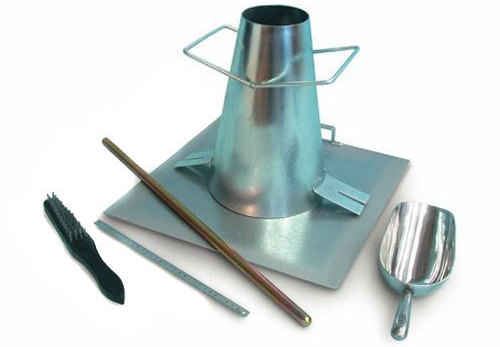This test is performed to check the consistency of freshly made concrete. The slump test is done to make sure a concrete mix is workable. The measured slump must be within a set range, or tolerance, from the target slump.

Workablility of concrete is mainly affected by consistency i.e. wetter mixes will be more workable than drier mixes, but concrete of the same consistency may vary in workability. It can also be defined as the relative plasticity of freshly mixed concrete as indicative of its workability.
Tools and apparatus used for slump test (equipment):
- Standard slump cone (100 mm top diameter x 200 mm bottom diameter x 300 mm high)
- Small scoop
- Bullet-nosed rod (600 mm long x 16 mm diameter)
- Rule
- Slump plate (500 mm x 500 mm)

Procedure of slump test for concrete:
- Clean the cone. Dampen with water and place on the slump plate. The slump plate should be clean, firm, level and non-absorbent. Collect a sample of concrete to perform the slum test.
- Stand firmly on the footpieces and fill 1/3 the volume of the cone with the sample. Compact the concrete by ‘rodding’ 25 times. Rodding means to push a steel rod in and out of the concrete to compact it into the cylinder, or slump cone. Always rod in a definite pattern, working from outside into the middle.
- Now fill to 2/3 and again rod 25 times, just into the top of the first layer.
- Fill to overflowing, rodding again this time just into the top of the second layer. Top up the cone till it overflows.
- Level off the surface with the steel rod using a rolling action. Clean any concrete from around the base and top of the cone, push down on the handles and step off the footpieces.
- Carefully lift the cone straight up making sure not to move the sample.
- Turn the cone upside down and place the rod across the up-turned cone.
- Take several measurements and report the average distance to the top of the sample.If the sample fails by being outside the tolerance (ie the slump is too high or too low), another must be taken. If this also fails the remainder of the batch should be rejected.
